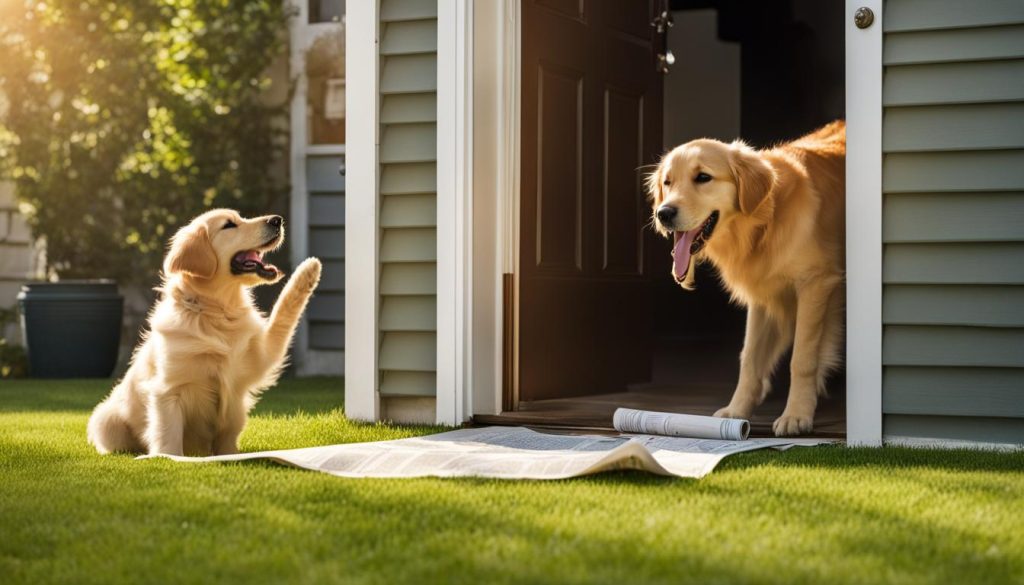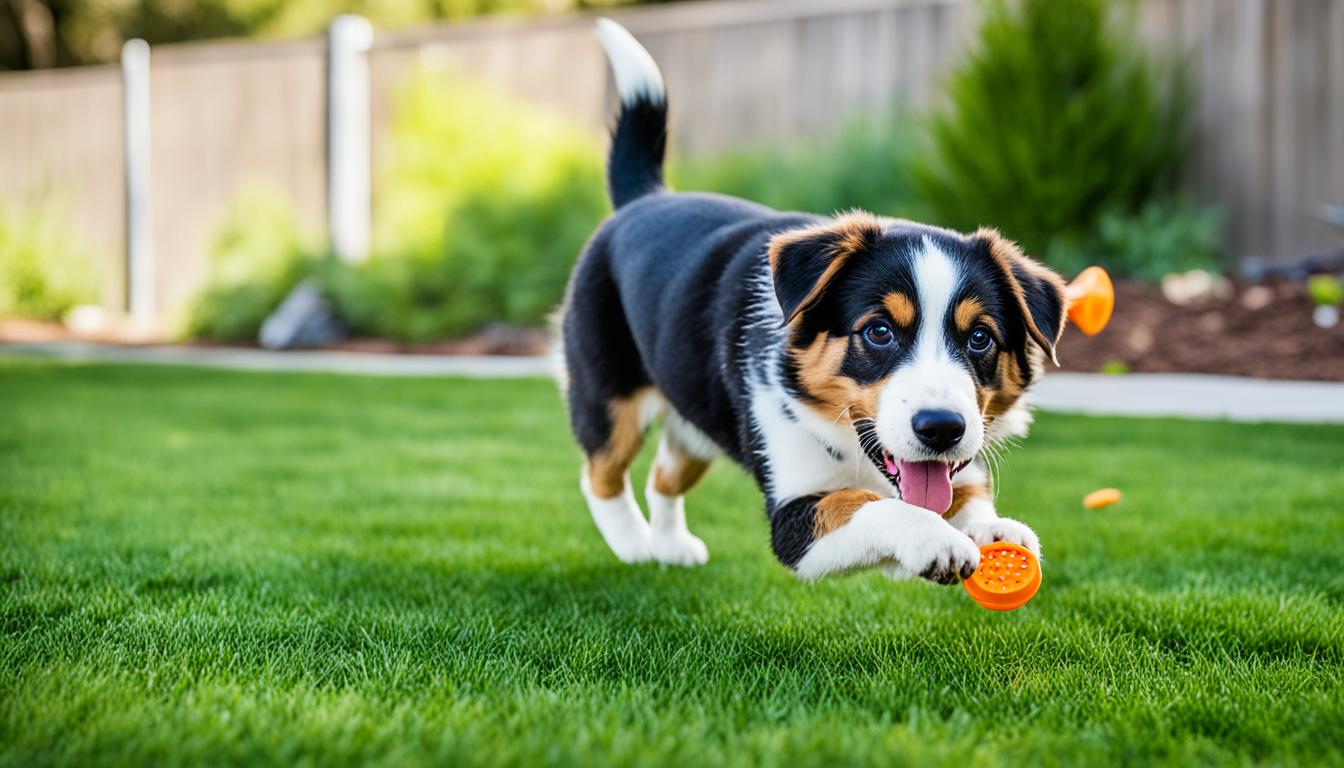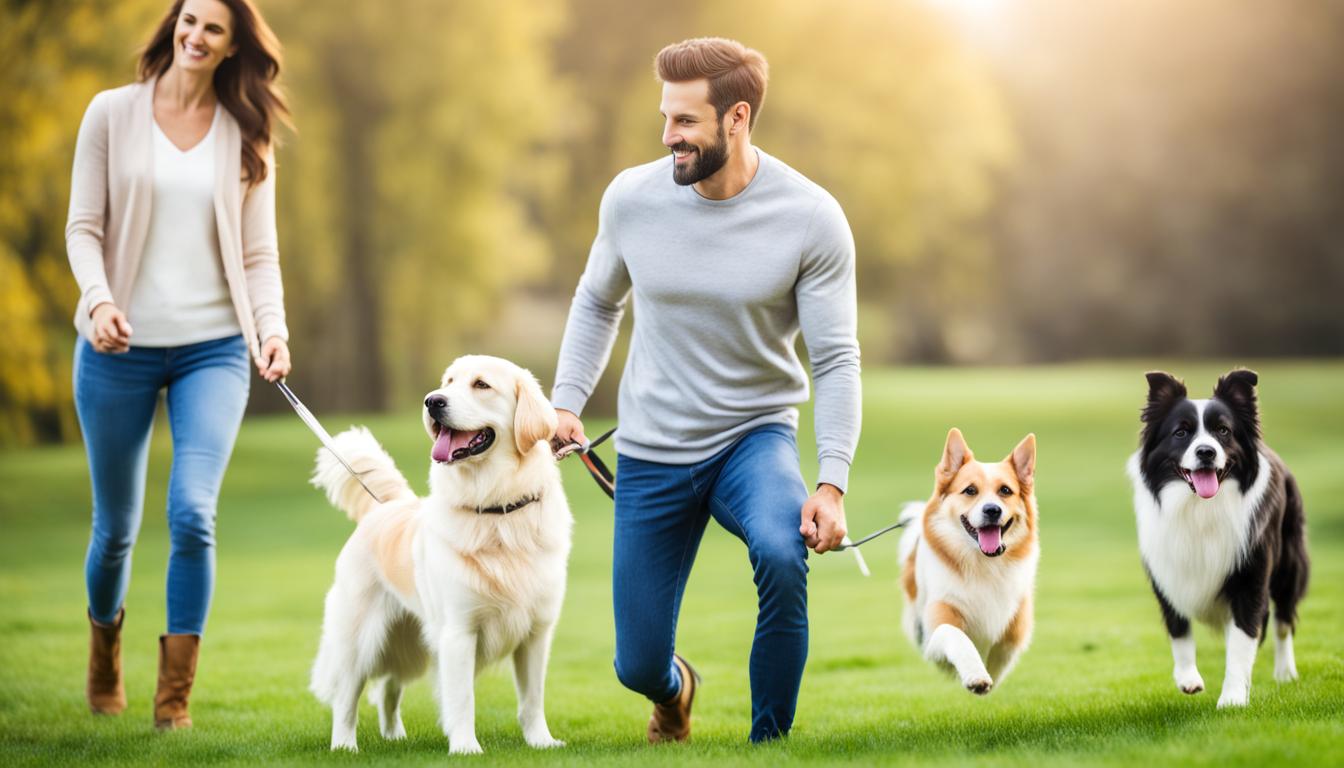Did you know that proper puppy training can prevent behavior problems and improve the overall well-being of your furry friend? Training your puppy not only ensures their obedience but also helps establish a strong bond between you and your pet. Whether you’re a first-time dog owner or have had dogs before, understanding the essentials of puppy training is crucial to raising a well-behaved and happy canine companion.
Key Takeaways:
- Proper puppy training is essential for preventing behavior problems.
- Training your puppy establishes a strong bond between you and your pet.
- Understanding the essentials of puppy training is crucial for raising a well-behaved dog.
- Consistency and positive reinforcement are key to successful puppy training.
- Seek professional help if you encounter any challenges along the way.
The Importance of Obedience Training
Obedience training is crucial for puppies as it helps establish a strong bond between the owner and the dog, promotes good behavior, and ensures their safety. Through positive reinforcement training techniques, such as rewarding desired behaviors with treats or praise, you can teach your puppy basic commands like sit, stay, come, and heel. Consistency, patience, and regular training sessions are key to successful obedience training.
“Training is not only about teaching basic commands; it’s also about building trust and creating a harmonious relationship with your puppy.”
When you invest time and effort in obedience training, you provide your puppy with essential skills that will benefit them throughout their life. Here are some reasons why obedience training is vital:
1. Establishing a Strong Bond
Obedience training strengthens the bond between you and your puppy. By working together and communicating effectively, you develop mutual trust and understanding. This bond forms the foundation for a lifelong relationship built on love, respect, and cooperation.
2. Promoting Good Behavior
Effective obedience training helps your puppy develop good behavior habits. By consistently reinforcing positive actions, you encourage them to make the right choices and avoid unwanted behaviors. This leads to a well-behaved dog that is a joy to be around.
3. Ensuring Safety
Obedience training plays a vital role in keeping your puppy safe. Teaching commands like “come” and “stay” can prevent them from running into dangerous situations or approaching potentially harmful objects. Training helps you maintain control in different environments, providing a level of safety for both your puppy and others.
Positive reinforcement training techniques are highly effective for obedience training. By rewarding desired behaviors with treats, praise, or playtime, you motivate your puppy to repeat those actions. This positive approach creates a happy learning environment and builds your puppy’s confidence.
Puppies are eager to please and learn quickly, but patience and consistency are essential in the training process. Regular training sessions, short and frequent, help reinforce commands and prevent your puppy from forgetting what they’ve learned. Make training sessions enjoyable for both you and your puppy, using treats, toys, and enthusiastic praise to keep them engaged.
Remember, obedience training is an ongoing process that requires dedication from both you and your puppy. By investing time and effort into their training, you are setting them up for a happy, well-behaved life as part of your family.
Housebreaking Puppies
Housebreaking, or potty training, is an essential part of puppy training. It involves teaching your puppy where and when to eliminate. The key to successful housebreaking is establishing a routine, taking your puppy to the designated elimination area frequently, and rewarding them for going in the right place. It’s important to be consistent, patient, and avoid punishment when accidents happen. With time and proper training, your puppy will learn to be clean in your home.
During the housebreaking process, it’s vital to establish a designated elimination area for your puppy. This can be a specific spot in your yard or a designated area indoors if you plan to use indoor potty pads or a litter box.
Take your puppy to the designated area at regular intervals, especially after meals, naps, playtime, and waking up in the morning or from naps. Use a consistent command or cue, such as “go potty” or “do your business,” to encourage them to eliminate.
The Power of Positive Reinforcement
When your puppy eliminates in the designated area, be sure to provide immediate praise and rewards. Positive reinforcement, such as treats, verbal praise, or a favorite toy, helps reinforce the desired behavior and encourages your puppy to repeat it.
Remember, positive reinforcement is essential for effective training. Avoid scolding or punishing your puppy for accidents. This may create fear or anxiety, hindering the housebreaking process.
If accidents happen inside your home, avoid punishing your puppy. Instead, clean up the mess using an enzymatic cleaner to eliminate any lingering scent that might attract your puppy to the same spot again.
Consistency is key when housebreaking your puppy. Stick to a regular routine of taking them to the designated elimination area and rewarding them for appropriate elimination behavior. With time and patience, your puppy will learn to associate the designated area with the act of eliminating.

Tips for successful housebreaking:
- Establish a routine and take your puppy to the designated area frequently.
- Use positive reinforcement, such as treats or verbal praise, when your puppy eliminates in the right place.
- Be patient and consistent; accidents are part of the learning process.
- Avoid punishment or scolding when accidents happen.
- Clean up accidents promptly using an enzymatic cleaner to remove odors.
Socializing Your Puppy
Socialization plays a crucial role in a puppy’s development. It involves exposing your puppy to different people, animals, environments, and experiences to help them become well-adjusted and confident. By providing positive reinforcement during socialization outings, such as giving treats and praise, you can encourage good behavior in your puppy.
Starting socialization from an early age is vital. Gradually exposing your puppy to new situations can prevent fear or aggression as they grow older. Remember, the goal is to help your puppy feel comfortable and secure in various environments, whether it’s meeting new people, encountering other animals, or exploring unfamiliar places.
During socialization outings, keep your puppy on a leash to ensure their safety and control their interactions. Always prioritize their well-being and monitor their comfort level. Gradually increase the level of difficulty by exposing them to more challenging situations as they become more confident and comfortable.
Benefits of Puppy Socialization
Puppy socialization offers numerous benefits:
- Helps prevent fear and aggression
- Promotes confident behavior
- Paves the way for positive interactions with people and animals
- Creates a well-rounded and adaptable adult dog
Remember, every interaction counts in the socialization process. From friendly encounters with other dogs at the park to visits to the veterinarian, each experience helps shape your puppy’s behavior and temperament.
Tips for Successful Puppy Socialization
- Start early: Begin socializing your puppy as soon as you bring them home. The critical socialization period for puppies is between 3 and 14 weeks old.
- Expose to different environments: Introduce your puppy to a variety of environments, such as parks, streets, and homes, to help them become accustomed to different sights, sounds, and smells.
- Positive reinforcement: Reward your puppy’s good behavior during socialization outings with treats, praise, and affection. This will reinforce positive associations with new experiences.
- Gradual exposure: Gradually expose your puppy to new situations, focusing on one new experience at a time. This allows them to build confidence and prevents overwhelming them.
- Socialize with different animals: Arrange controlled interactions with other puppies, friendly adult dogs, and other animals to teach your puppy appropriate social skills.
- Professional guidance: Consider enrolling your puppy in puppy socialization classes or consulting a professional dog trainer for expert guidance and support.
Remember, socializing your puppy is an ongoing process. Continue exposing them to new experiences and reinforcing positive behavior throughout their lives. By prioritizing socialization, you’re setting the foundation for a well-adjusted and happy adult dog.
| Benefits of Puppy Socialization |
|---|
| Helps prevent fear and aggression |
| Promotes confident behavior |
| Paves the way for positive interactions with people and animals |
| Creates a well-rounded and adaptable adult dog |
Crate Training Puppies
Crate training is a valuable tool for puppy training, offering a secure and comfortable space for your furry friend when they can’t be supervised. Not only does crate training help with housebreaking, preventing destructive behavior, and creating a den-like environment, but it also promotes a sense of security and independence for your puppy.
“Crate training can be highly beneficial for both puppies and their owners. It provides a safe and dedicated space for puppies, preventing them from engaging in harmful or unwanted behavior when left alone.”
To successfully crate train your puppy, it’s important to introduce the crate gradually and make it a positive experience. Start by placing treats and toys inside the crate to entice your puppy to enter willingly. Never use the crate as a form of punishment, as this can create negative associations.
Creating a routine for crate time is crucial. Start with short periods and gradually increase the duration as your puppy becomes more comfortable. This will help them develop a positive association with the crate and reduce any anxiety or distress they may feel initially.
- Choose an appropriately sized crate for your puppy. It should be small enough to create a cozy space but large enough for them to stand, turn around, and lie down comfortably.
- Place the crate in an area where your puppy can still feel connected to the family, but away from any distractions or noise.
- Introduce your puppy to the crate gradually. Start by leaving the crate door open and allowing them to explore it at their own pace.
- Encourage your puppy to enter the crate by using treats or their favorite toys. Use positive reinforcement to create a positive association with the crate.
- Once your puppy is comfortable entering the crate, begin closing the door for short periods. Stay nearby and provide reassurance and praise.
- Gradually increase the duration your puppy spends in the crate, making sure to provide regular potty breaks and exercise outside of the crate.
Remember, crate training should be a positive and gradual process. It’s essential to never force your puppy into the crate or use it as a place of confinement. With patience, consistency, and positive reinforcement, crate training can be a valuable tool in teaching your puppy good behavior and providing them with a safe and comforting space of their own.
Managing Puppy Behavior
Understanding and managing puppy behavior is crucial for successful puppy training. Puppies, like humans, have their unique behaviors and tendencies that require careful attention and guidance. It is important to address these behaviors early on to ensure a well-behaved canine companion.
Common Puppy Behaviors
When it comes to puppy behavior, there are a few common issues that owners often encounter. These include:
- Chewing: Puppies explore the world with their mouths and may chew on furniture, shoes, or other household items.
- Biting: Puppies go through a teething phase and may nip or bite during play or when seeking attention.
- Jumping: Puppies have a lot of energy and may jump up on people as a form of greeting or excitement.
- Excessive Barking: Puppies may bark excessively when they are bored, anxious, or seeking attention.
It’s essential to understand that these behaviors are natural for puppies and can be addressed through proper training and guidance.
“A well-trained puppy is a happy puppy, and a harmonious pet-owner relationship is built through effective management of their behavior.”
Positive Reinforcement Training
Positive reinforcement training is an effective method for managing puppy behavior. This training technique involves rewarding good behavior and redirecting unwanted behaviors towards appropriate alternatives.
For example, when a puppy chews on a shoe, instead of scolding them, redirect their attention to a chew toy and reward them when they chew on it instead. This approach encourages the puppy to engage in desired behaviors and discourages unwanted ones.
Clicker Training
Clicker training can be a useful tool for managing puppy behavior. It involves using a clicker, a small device that makes a distinct sound, to mark desired behaviors. By associating the sound of the clicker with a reward, such as a treat or praise, you can reinforce positive behaviors in your puppy.
“Training a puppy is not just about correcting unwanted behaviors but also about nurturing their positive traits.”
Redirecting Attention
Redirecting your puppy’s attention is an effective way to manage unwanted behaviors. For example, if your puppy starts jumping on you, instruct them to sit and reward them for obeying the command. This redirects their energy towards a more appropriate behavior.
The Power of Patience
Patience is key when managing puppy behavior. Remember that your puppy is still learning and exploring the world, and it may take time for them to understand what is expected of them. Consistency, positive reinforcement, and patience will help shape your puppy’s behavior over time.
| Behavior | Management Technique |
|---|---|
| Chewing | Provide appropriate chew toys and redirect their attention when they chew on inappropriate items. |
| Biting | Teach bite inhibition, discourage biting through positive reinforcement, and provide appropriate chew toys. |
| Jumping | Ignore the jumping behavior and reward calm behavior, teach the “sit” command as an alternative. |
| Excessive Barking | Identify and address the underlying cause of barking, provide mental and physical stimulation, and reward quiet behavior. |
Conclusion
Puppy training is an essential part of responsible dog ownership. It requires dedication and consistency, but the rewards are worth it. By investing time and effort in training your puppy, you can establish a strong foundation for a well-behaved and happy adult dog.
Throughout the training process, it’s important to remember that each puppy is unique with their own individual needs. Tailoring your training methods to suit their personality and learning style will yield the best results.
If you encounter any challenges or feel overwhelmed, don’t hesitate to seek professional help. Experienced trainers can provide guidance and support, ensuring you and your puppy have the tools you need to succeed.
With the right approach, positive reinforcement, and plenty of patience, you can forge a lifelong bond with your furry friend. So, start your puppy training journey today and watch as your puppy transforms into a well-behaved, obedient, and beloved member of your family.



